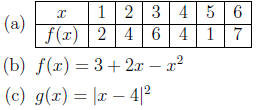Math Worksheet
1.
(a) State the definition of a one-to-one function.
(b) State the definition of an inverse function.
2. Determine whether the following functions are one-to-one.

3. If f is a one-to-one function such that f(2) = 9, what
is f -1(1)?
4. If
 ,find f -1(1)
,find f -1(1)
5. find a formula for the inverse of a function. Sketch the graphs of the
function and its
inverse and verify that you have found the inverse correctly.

6. Find


7.
(a) If we shift a curve to the left, what happens to
its reflection about the line y = x?
In view of this geometric principle, find an expression for the inverse of g (x)
=
f (x + c), where f is a one-to-one function.
(b) Find an expression for the inverse of h (x) = f (c x), where c ≠ 0
8. (a) If f is a one-to-one, twice differentiable function with inverse function
g, show
that

(b) Deduce that if f is increasing and concave upward,
then its inverse function is
concave downward.
9. Recall the following theorem from the text.
Theorem. If f is a one-to-one differentiable function with inverse function g =
f -1
and
 , then the inverse function is differentiable at a and
, then the inverse function is differentiable at a and

The purpose of this problem is to guide you through the
proof of this theorem.
(a) State the definition of the derivative of g at the point x = a.
(b) Using the definition of an inverse function and that g (x) = y, g (a) = b find f (y)
and f (b).
(c) Rewrite the definition from part (a) using the notation in part (b).
(d) Why is g = f -1 continuous? So, if x→a then g (x)→?
(e) Use the limit laws to recognize that

(f) Finally, use the notation of part (b) to rewrite the result obtained in (e)
to get
the desired result.


